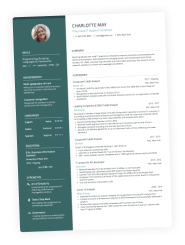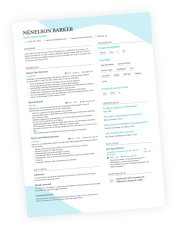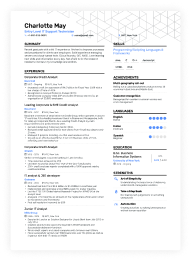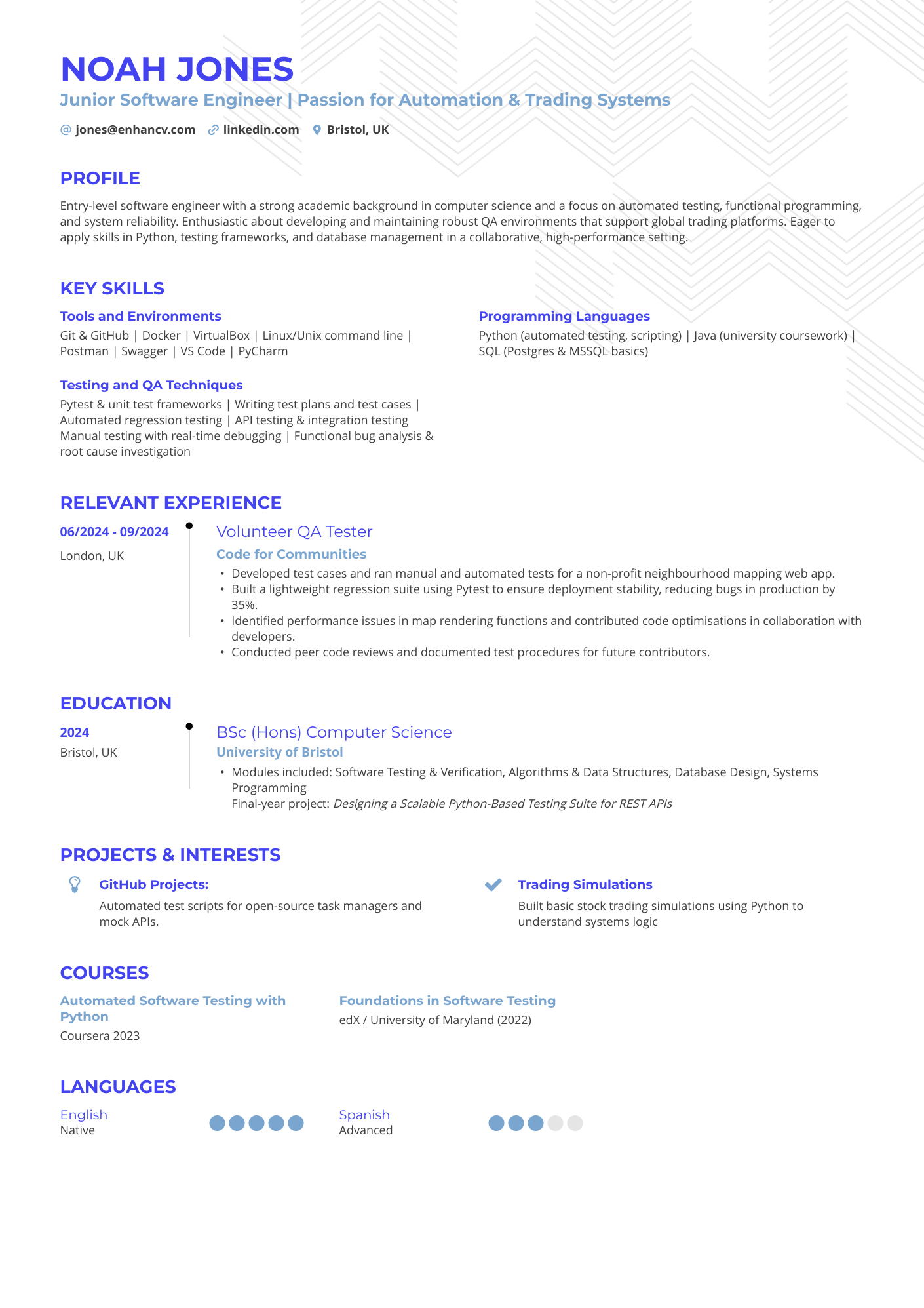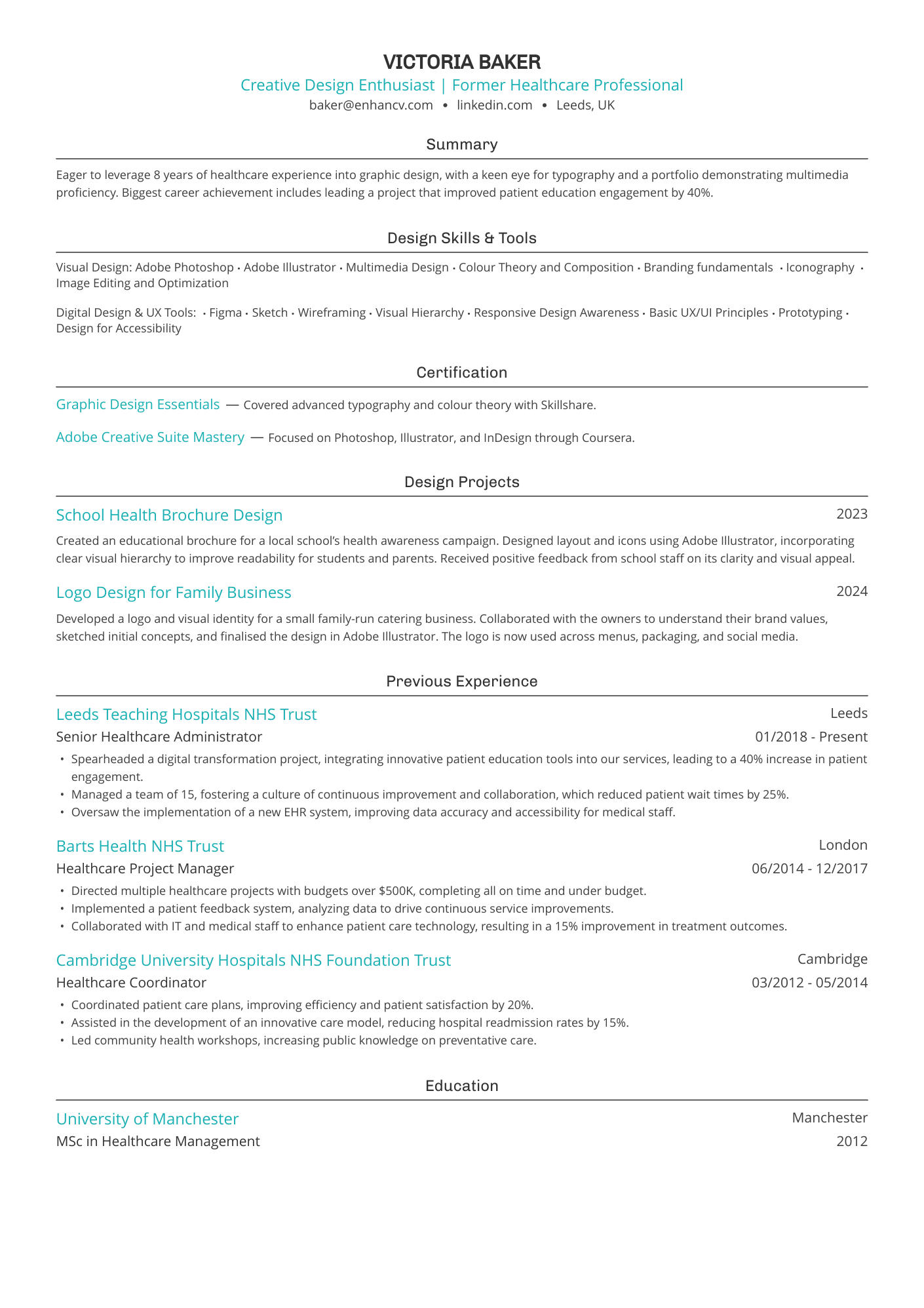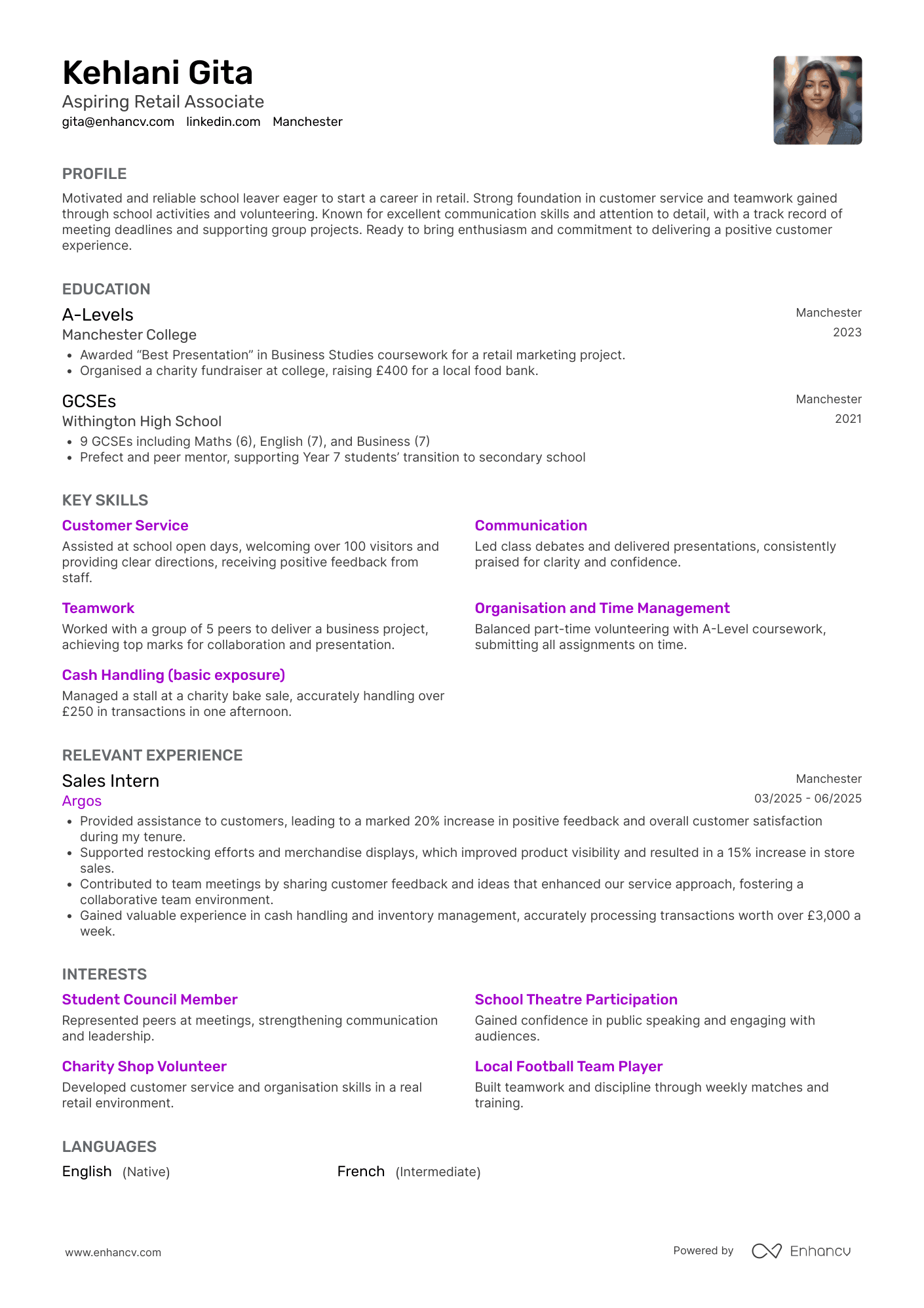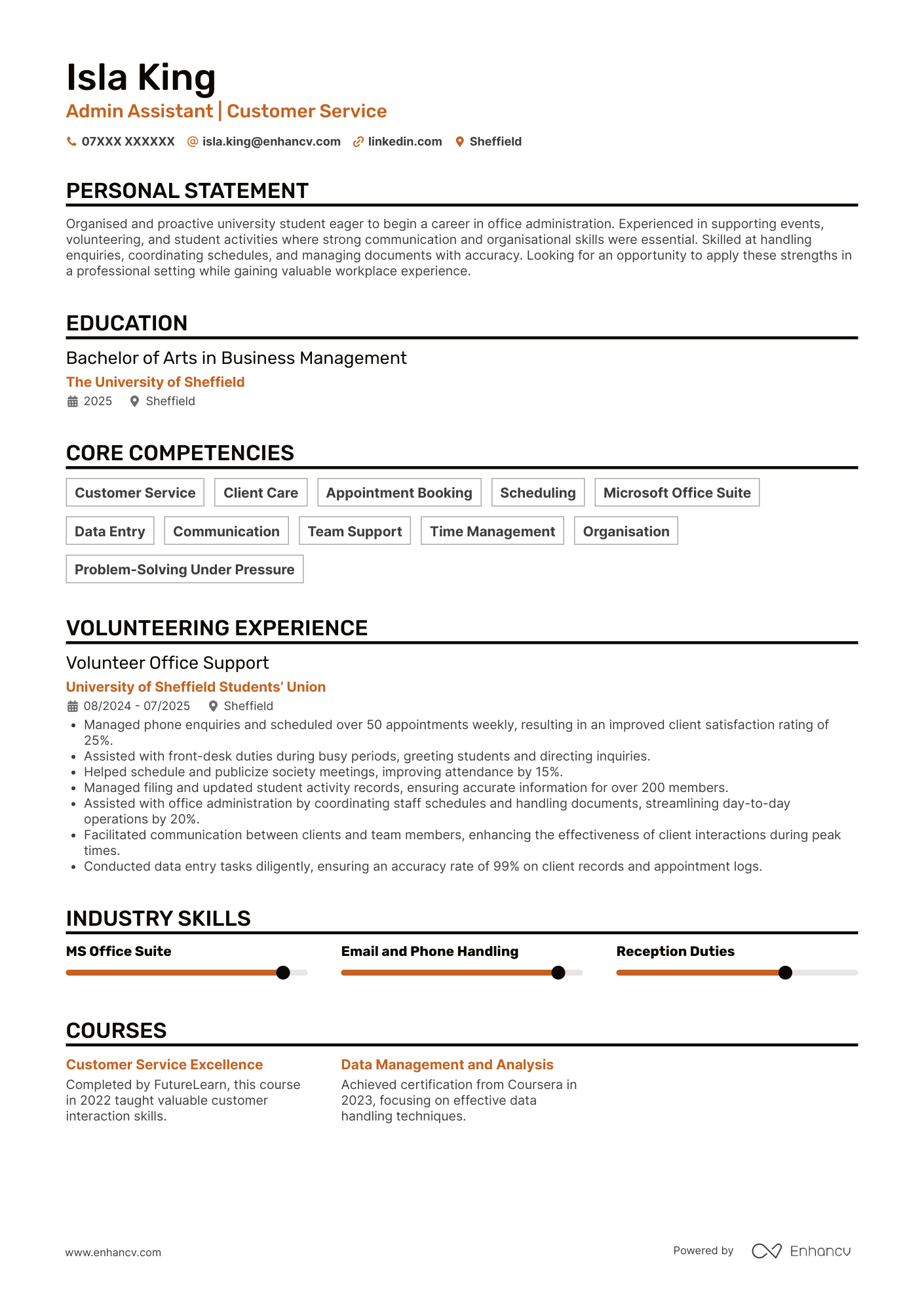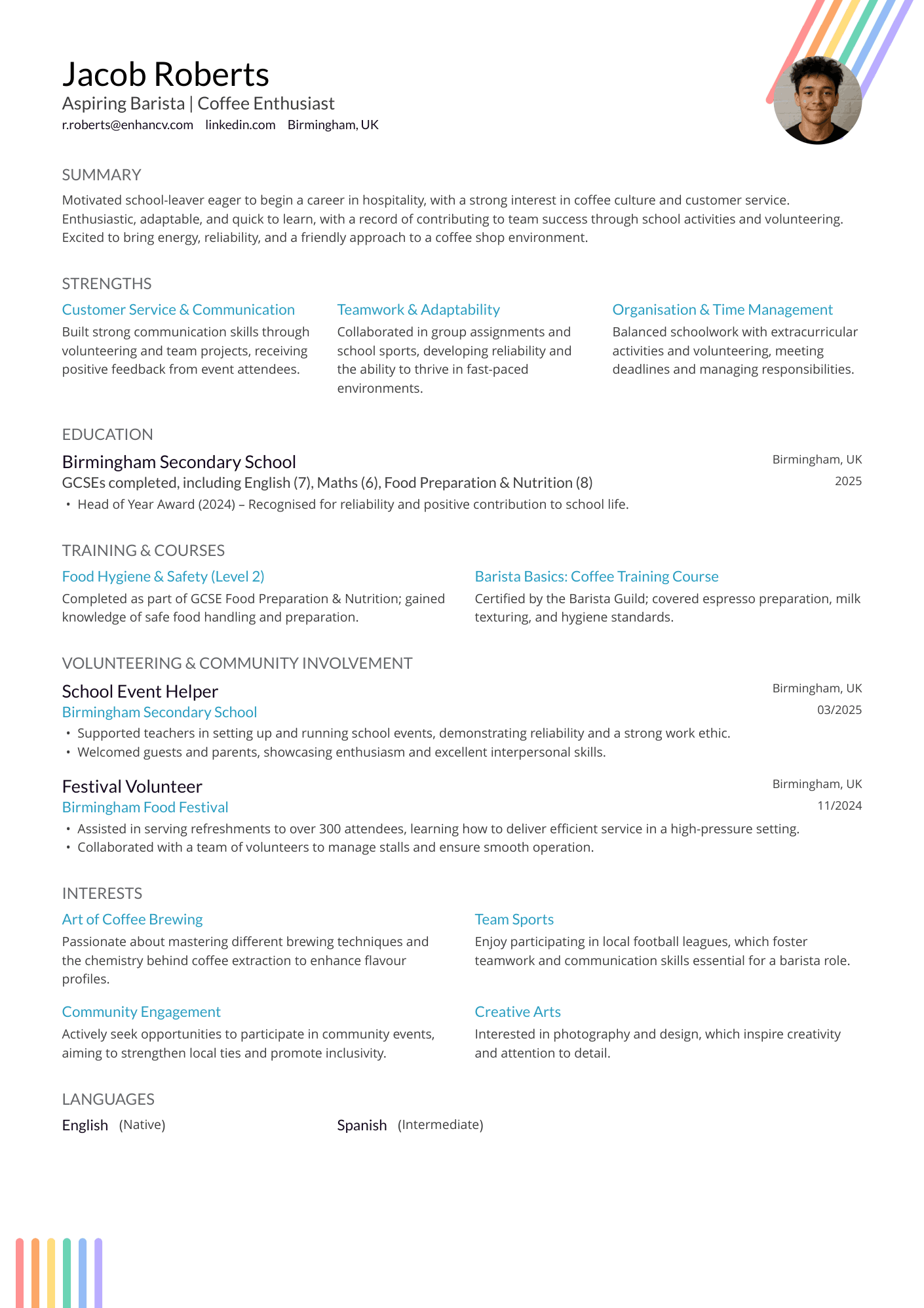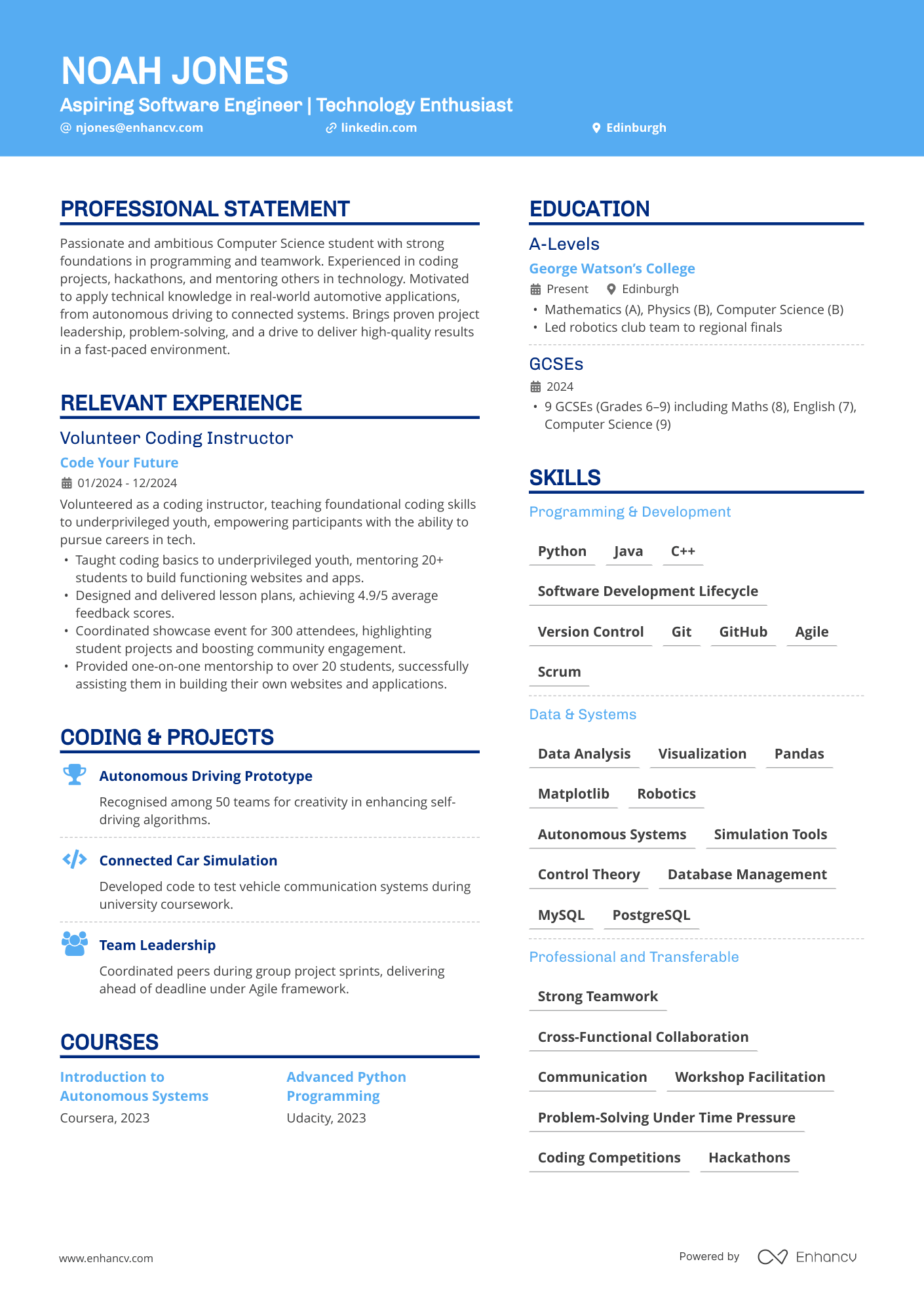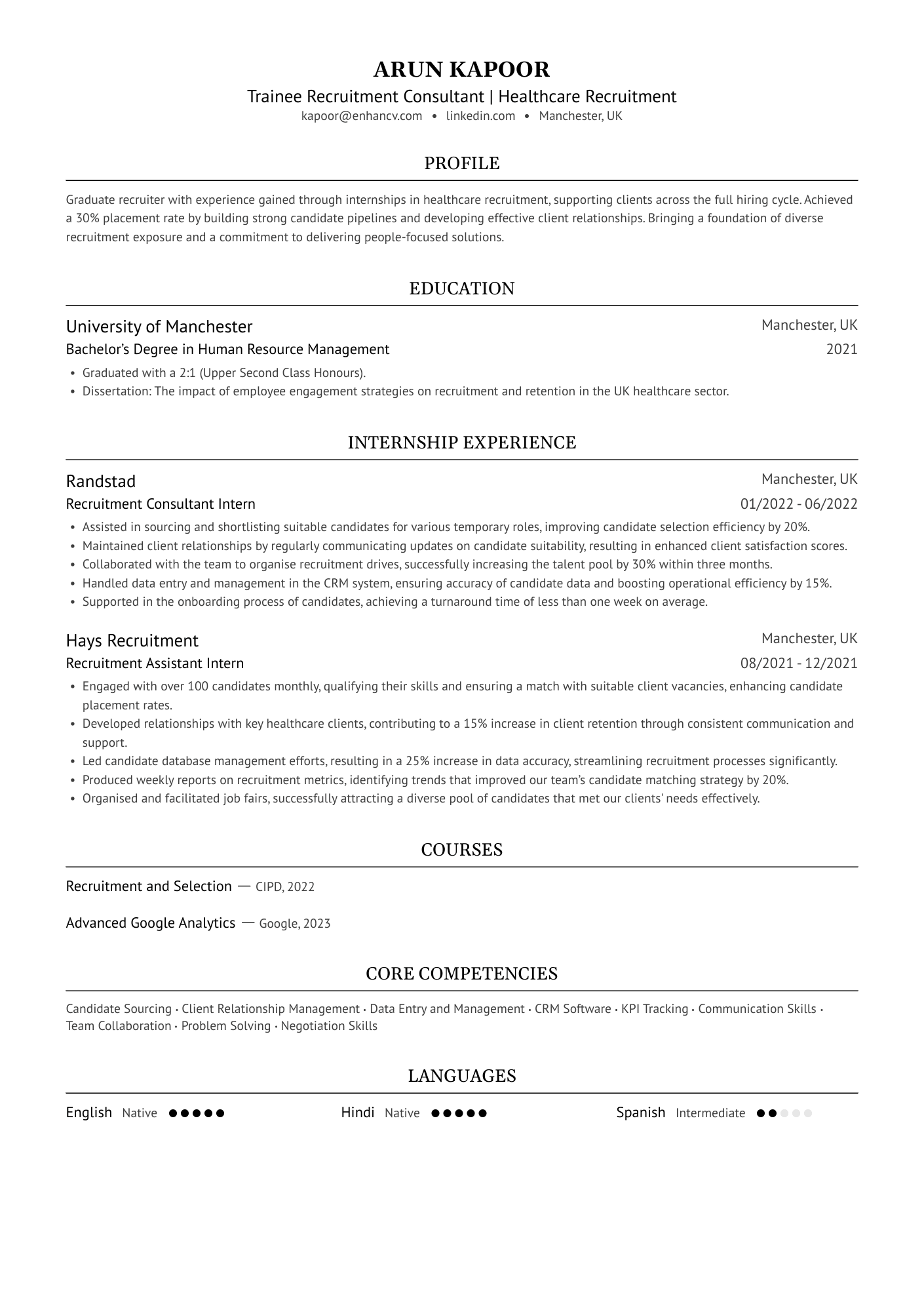Landing your first job can feel like Catch-22. You need experience to land a job, but you need to land a job to get experience. It’s frustrating to say the least. If you’ve been staring at a blank page before you and hoping inspiration will suddenly strike, you’re not alone. We’ve all been there at some point in our careers.
The good news is that you’ve come to the right place. Writing your first job CV isn’t about faking it until you make it, and the last thing you want to do is pack it full of half-truths or exaggerations. Instead, this document should showcase your potential and highlight what you’re capable of. That means leaning heavily on your skills over your experience or—let’s be honest—your lack of real-world experience.
In this guide, we’ll take you through the basics and share some good CV examples for your first job. You’ll learn how to get started with writing a CV, what points to emphasise in a first job application, and the most common mistakes you avoid.
Read on to get the inside scoop on positioning yourself.
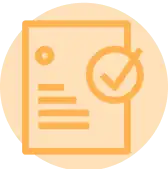
Key takeaways
- Keep your first-job CV to just one page.
- Focus on transferable skills over work experience.
- Highlight education, projects, and volunteering.
- Show enthusiasm and potential in your personal statement.
- Tailor your CV to the specific role you’re applying for.
- Use clear formatting and proofread carefully to avoid errors.
Is your entry-level CV working for you? Upload it below and find out where it’s lacking.
Is your CV good enough?
Drop your CV here or choose a file. PDF & DOCX only. Max 2MB file size.
First things first, let’s get started with a definition of what a CV for a first job actually is.
What is a first job CV?
A first job CV is one for candidates with little or no work experience. Often enough, this means school or university leavers, but it can be anyone who hasn’t done paid work before.
It’s important to understand that this is not the same as a standard CV. Since you lack work experience, you’ll need to focus on other attributes.
Check out our table below to better understand the differences.
First job CV vs standard experienced CV: key differences
| First job CV | Standard CV |
|---|---|
| Uses a skills-based (functional) format. Adopts a structure that prioritises skills and education over work history. | Usually has a reverse chronological format. This is a linear structure that highlights candidates’ career story. |
| Focuses on education. Emphasises GCSEs, A-levels, and coursework. | Focuses on work history. Prioritises professional roles and career highlights. |
| Draws on transferable skills. Spotlights soft skills you gained at school, university, or in volunteering, and part-time work. | Pinpoints specific experience. Details industry-specific skills and professional accomplishments with metrics. |
| May note certain school projects. Academic assignments and group projects can demonstrate core capabilities. | Shares work-based achievements and projects. Can include professional projects with business impact and results. |
| Relies on extracurriculars too. This can include sports teams, societies, and volunteering to show character and skills. | Highlights professional development. May include training courses, certifications, and industry networking. |
| Shows real enthusiasm. What you lack in experience, you can make up for in enthusiasm in your personal statement. | Has a proven track record. Your summary focuses on work-based achievements and quantified results. |
| Short and sweet. First job CVs typically don’t need to be more than one page long. | Can be two (or more) pages. A standard CV is a detailed overview of candidates’ professional history. |
We won’t beat around the bush. The UK job market is tough, and you’re unlikely to land a job on your first try. If you get ghosted or rejected, it can certainly knock your confidence. However, you should understand that this is just part of the job-seeking process.
While it will always be challenging, there are some pitfalls that first-time job seekers tend to make all of the time. Avoid them, and you instantly boost your chances.
Here’s a rundown of why many first-job CVs fail:

Why many first-job CVs fail
- They’re too vague: They lack the specific detail hiring managers are looking for. Writing things like “hard worker” or “determined” won’t land you a job.
- They focus on duties, not achievements: Writing what you did at school is unlikely to grab the reader’s attention. Instead, you should emphasise how your efforts contributed to results.
- They have poor formatting: You don’t need to be a designer to perfect the look of your CV. Make sure it’s clean, professional, and easy to read.
- They’re too long: Are you trying to overcompensate? Packing your first job CV with loads of information will overwhelm the reader, and won’t do you any favours.
- They don’t connect the dots: You should link your accomplishments to the duties of the job you’re applying for. This helps to fill in any blanks for the hiring manager.
- They are rushed (and it shows!): You need to take the time to write a good first CV. Don’t rush this task or you could end up with typos and mistakes.
We’ve touched upon what makes a poor CV. Now let’s move onto the bright side.
What makes a good first job CV?
When you’re writing you’re first job CV, it’s important to focus on what you do have—i.e. skills and enthusiasm—over what you don’t have.
While you may be tempted to tell a few white lies along the way, this is a bad move. When you’re found out (and, frankly, you will get found out), you can end up jeopardising your professional future.
The best first job CVs do not attempt to imitate experienced workers. They are directed at flexibility, a desire to study and the possibility to make contributions immediately.
How can you make sure you’re hitting the mark with your first CV?
To help you get started, we’ve made a simple checklist you can use as you’re working on your application.

Qualities of a good first job CV
- Concise and to the point: Your first CV should usually be no longer than one page. If you’re running onto two pages, it’s time to do some editing.
- Highlights transferable skills: It should focus on the skills you’ve honed over the years—in the classroom and beyond—that apply to this role.
- Show some enthusiasm: Make sure the tone you use is proactive and professional. This is a quick way to draw hiring managers to your application.
- Features relevant examples: You may not have work-based examples, but you need to think outside the box. Look for achievements from your school, projects, volunteering, or any part-time roles you’ve undertaken.
- Tailored to the role: Don’t use a one-size-fits-all approach to CV writing. Be sure to tailor your CV to meet the demands of the job for which you’re applying.
- Clear formatting: Use a design or structure that is easy to read on a screen or paper. That way, the hiring manager will have no issue reviewing your CV.
Don’t get too hung up on the fact that you’re new to the workforce. Everyone has to start somewhere. When you’re working on your CV for your first job, draw on any experiences you’ve had up until now. It may be completing the Duke of Edinburgh’s Award, for example, or helping out at your local church.
Consider what will make you stand out in a sea of otherwise similar candidates. If you’ve done anything that’s likely to make the recruiter say “wow,” make sure you include it in your CV immediately.
First-job CVs are all about potential. Most candidates will have some work experience and transferable skills, but are less likely to have very relevant experience.
Clear communication, attention to detail and enthusiasm always stand out. How candidates highlight their transferable skills shows their thought process.
Remember: Hiring managers see new candidates all of the time. Be upfront about your lack of work experience, and then lean on your potential, excitement, and—if relevant—your flexibility, too.
How to choose the right format for your first CV
When writing a CV, the most common format is the reverse-chronological order. This is what hiring managers expect to see, as it emphasises your work history over your other attributes. However, since you’re new to the working world, you lack professional experience. So, this is not the way to go.
Instead, you have two options: the skills-based format or the combination format.
Let’s take a look at each of these choices below.
Skills-based CV
The skills-based (functional) format leads with your skills, and groups any experience you have below them. It gives you the opportunity to shine a light on your talents regardless of where you’ve honed them.
So, for instance, if you’ve learned how to use Canva for your own designs, you can add it here for all to see.
Since this structure is flexible, you can weave in any experience you do have. Under each skills heading, slide in how you’ve applied it and what level you tend to work at. Sharing tangible examples means the hiring manager will have something concrete to go on when reviewing your CV.
Combination CV
Also known as a hybrid CV format, the combination CV emphasises your skills while still listing your work history in reverse chronological order. It’s usually ideal for mid-level professionals and career changers. However, if you have a ton of casual experience—such as volunteer positions—you can use this structure to draw attention to that.
Should your first job CV be ATS-friendly?
Chances are, you’ve heard of applicant tracking systems (ATS). This is a type of CV-reviewing software that some recruiters use when screening candidates. However, it’s much more common in corporate settings than, say, casual shift work. But should you keep it in mind?
The short answer is yes. You never know when hiring managers are relying on AI scanners to filter incoming CVs. The easiest way to create an ATS-friendly application is to use a simple format. Make sure that your CV is accessible for both human eyes and any sneaky systems.
It’s best to:
- Stick to a clean, single-column layout.
- Use standard section headings (e.g. Education, Skills, Experience).
- Avoid graphics, images, and text boxes.
- Save and send your CV as a PDF (unless asked for Word).
- Keep fonts professional and easy to read (e.g. Arial, Calibri, Rubik)
If you get that part of the equation right (and create a good first CV), you should have no problem with this software. ATS can handle any CV format—reverse chronological, skills-based, or combination—as long as you integrate the keywords from the job post and follow the simple rules above.
Next up, the essential steps to writing your first-job CV.
How to write a CV for your first job
Not sure where to begin? Let us walk you through the steps. If this is the first time you’re writing a CV, you might find the idea intimidating. It doesn’t have to be.
Check out the process below.
Step 1: Start with your contact details
First up, it’s time to write your CV header. This is often the first thing that hiring managers see. Keeping it simple is the key.
Here’s what your header typically includes:
- Your name and headline: Kick things off by writing your full name with a job title. Since you’ve never had a job before, you might want to put something like “Aspiring Marketer” or “Graduate Writer”.
- Location: Don’t include your full address. Just add your location, i.e. the city or town and country.
- Phone number: Write down your phone number—your mobile is fine.
- Email address: Add a professional email address. If in doubt, one with your full name will do.
- LinkedIn profile: If you have a LinkedIn page (and it matches your CV!), include a hyperlink.

PRO TIP
Looking to land a job in the creative fields?
If you’ve built up a portfolio while at school, college, or university, you can link to it in your header. This is particularly useful for aspiring illustrators, graphic designers, marketers, and writers.
Let’s take a quick look at a good header example:
Alex Taylor
Graduate Marketer
Tel: 07123 456 7XX | Email: alex.taylor@email.com | LinkedIn: linkedin.com/in/fullname | Manchester, UK
Use this example as inspiration when you’re writing your header.
Step 2: Create a smart personal statement
When you’ve perfected your header, the next step is to add a personal statement. This is the most freeform part of your first job CV, and it’s a chance to showcase your positive outlook.
Also known as a profile, this statement tells the hiring manager what makes you different. It should include your unique selling point (USP), i.e. the thing that makes you stand out from the crowd.
You can focus on:
- Any outstanding academic achievements
- Special skills you’ve honed (that align with the job)
- Your career aspirations, and how they align with the company’s goals
- Any relevant experience you do have
- Awards or notable moments from your schooling

Make your words count!
Pepper your personal statement with action verbs and grab the reader’s attention. Top examples include the following:
- Empowered
- Cultivated
- Instigated
- Directed
- Advised
- Tracked
- Fixed
- Visualised
- Measured
Check out our example below for some inspiration:
Personal statement
Marketing graduate with experience in social media, content creation, and market research. Led a student campaign that increased engagement by 40% and achieved a First-Class Honours degree. Looking to apply creativity and analytical skills in a graduate marketing role.
Add metrics—such as “increased engagement by 40%”—wherever possible. These solid figures show the hiring manager that you have what it takes to offer them real results in the workplace.
It’s also best to write this part of your first-job CV last. That way, you’ll be able to draw upon all of the feats you’ve written about and create an impactful statement.
Step 3: Emphasise your education
If you’re just leaving education, this should be fresh in your mind.
On a first-job CV, your education often carries more weight than your work history. That’s why a skills-based format places this section higher up, showing employers the knowledge and abilities you’ve already developed.
You should include your most relevant qualifications in reverse chronological order. That just means that you start with your most recent certificates, and work your way back in time.
Here’s what you can include:
- Degrees: If you have a degree (or even degrees—congrats!), list this at the top of the section.
- A-Levels (or equivalent): Add in your A-Levels, or the equivalent level 3 qualification you may have. For example, you might have an NVQ or a T Level.
- GCSEs: Instead of listing every subject, you can keep it brief by saying something like “8 GCSEs 8-5 Grades”. Of course, if you have a degree, you might want to leave these off your CV to save space. However, check the job description first.
- Extra certificates: Do you have any additional training or certificates? You can either list them here or you can create a dedicated certificate section.
How much detail should you add?
When listing your education, you need to include the following:
- Qualification name and subject (E.g. Journalism BA)
- The school, college, university, or provider
- The location of the above
- The year you gained the qualification
- Your grade plus any honours
Bonus: You can also slide in details of any coursework or projects you completed as part of the course. However, you should make sure that this aligns with the job you’re applying for.
If you’re unsure how to describe your educational background, follow the structure in our example.
Education
BSc Marketing – University of Manchester, Manchester
2021–2024 | First-Class Honours
- Completed dissertation on consumer engagement in digital marketing campaigns.
A-Levels – Manchester College, Manchester
2019–2021 | Economics (A), English Literature (B), Business Studies (A)
GCSEs – Oakwood High School, Manchester
2014–2019 | 8 GCSEs, Grades 9–5
Keep the layout simple and concise. You don’t need to add loads of bullet points below each qualification, just what’s relevant to the target job.
Step 4: Highlight any experience you have
Let’s deal with the elephant in the room. You likely don’t have a ton of experience. You wouldn’t be writing a first job CV if you did. However, consider whether you can draw upon anything you’ve done in the past for this section.
Think about any area of your life that has given you experience. This includes part-time jobs, summer jobs, volunteering, school projects, or even extracurricular leadership activities.
As Uku Sööt, Organizational Growth Strategist at IPB Partners explains, there are ways to think outside of the box if you lack traditional work experience:
In cases when a person lacks a history of work, I would advise them to position experiences as successes. One of my students told me she assisted her family business by reformatting their booking sheet in Excel to ensure that people did not book the same room twice.
We put that as 'enhancing a system and time saving.' It was creative and problem solving which are much more important than writing computer skills.
In our example below, the candidate turns any relevant experience they have—such as a volunteer role—into professional experience. Rather than labelling this section ‘Work experience,’ it may be wise to go with something like ‘Relevant experience.’ This shows you’re not trying to pass the positions off as paid jobs. Take a look here:
Relevant Experience
Marketing Intern
Manchester Student Society, University of Manchester
Jan 2023 – Jun 2023
- Directed a social media campaign that increased event attendance by 40%.
- Created engaging content for Instagram and LinkedIn, improving follower engagement.
- Conducted surveys to track student preferences, informing future campaigns.
Volunteer Coordinator
University Charity Week, Manchester
Sep 2022 – Mar 2023
- Led a team of 15 volunteers to organise fundraising events.
- Managed schedules and delegated tasks to ensure smooth event execution.
- Enhanced problem-solving and leadership abilities through real-time event management.
Be honest about the nature of any roles you include. For example, if something was part-time or voluntary, you need to say so. The last thing you want to do is mislead the hiring manager.
Step 5: Tailor your skills to the role
When writing a CV for a first job, your skills section does a lot of the heavy lifting. Focus on any transferable skills you’ve picked up. These include teamwork, communication, and problem-solving.
You’ll also want to emphasise your relevant technical skills. Knowing how to use the latest tech will make you look valuable to most businesses. This can include coding, IT, and even customer service tools.

Check the job description and criteria
Before you start writing your skills section, go back to the job posting. You should find a list of core criteria (i.e. key skills!) there.
See how many of the skills you already have, and place them front and centre in this section. Aligning your CV with the demands of the role is the fastest way to get noticed by hiring managers.
You can divide your skills into two categories: technical (hard skills) and soft skills. If you can do so, add context to each talent you pick out. Describe a time when you used it and in what situation. This gives the reader an idea of your skill in that area.
Here’s an example of how your skills section may look:
Key Skills
Tools
- Microsoft Excel: Created formulas to track expenses for a family holiday.
- Canva: Designed social media graphics for my personal accounts.
- Microsoft PowerPoint: Created and delivered presentations for classes of 45 students.
Soft Skills
- Organisation: Prioritised up-coming revision based on the order of my GCSE exams.
- Communication: Presented a talk to 300 students as part of leaving week.
- Time Management: Balanced a part-time job (15 hrs/week) with full GCSE course load.
You might also want to include your proficiency level next to each skill. This shows the hiring manager how good you are at each of the skills you’ve listed.
Optional extra sections
Do you have some extra space to play with? If so, there are some optional sections you can add.
Let’s break down each of them:
- Hobbies and Interests: Pick out pastimes that make you look good and align with the role. For example, being part of a debate team or reading industry magazines.
- Languages: Speaking a second language is a real bonus in most fields. Create a section, and also be clear about your level of fluency.
- Certificates and training: If you have multiple certificates that fall outside of your formal education, place them in a dedicated section.
Including hobbies can be contentious. My take is if they demonstrate teamwork, leadership or commitment, then a brief mention is worthwhile. Otherwise, leave them out.
Now you’re clear on how to structure your CV for a first job, let’s look at the best practices.
Best practices when writing your first-job CV
Before we move onto the examples, it pays to keep a few pointers in mind. Since you’re new to the world of CV writing, you may not know where to start. Follow these tips:
- Create a master CV. First things first, you should create a master CV that includes all your education, skills, and any relevant experience you have. Save this and create a new version every time you want to tailor it for a new job.
- Use AI sparingly. You may be tempted to get ChatGPT to write your CV. However, so is every other candidate. If you start here, you’ll end up with a carbon copy application that’s the same as all the rest. Instead, write your CV first and use AI to get suggestions and edits.
- Start with a template. You don’t have to be a design whiz to create your first CV. Instead, use a template, such as the simple templates we have, to make it easy.
- Save your CV as a PDF (not a Word file!). This is the standard approach in the UK, and makes you look professional. The only exception is if the job advert says you need to use a Word file. However, this is rare.
Next, we take a peek at five stellar CV examples.
5 first job CV examples
The style of CV you choose will depend on your path. No two careers are the same. Chances are, you have a bunch of different goals from other candidates. Lean into that.
In this part of the guide, we take a look at some prime first job CV examples for various scenarios:
Example 1: Retail assistant
This sales assistant CV is clean and easy to follow, with education placed at the top to showcase the candidate’s recent academic achievements. It highlights customer service, punctuality, and teamwork throughout, using clear, quantified examples drawn from internships, volunteering, and projects.
Example 2: Office role
This CV is tailored for an office-based role, with education placed at the top to emphasise recent academic background. It highlights organisation and IT skills, including Microsoft Office and data management.
The office admin CV also demonstrates responsibility through volunteering and university projects, while keeping the content concise so employers can quickly see the candidate’s suitability.
Example 3: Hospitality
The CV below stands out for the right reasons. Its clean design and focus on relevant skills convey enthusiasm and genuine interest in a barista role.
Example 4: First CV for an apprenticeship
This CV is a strong example for an apprenticeship because it highlights the key entry requirements — solid A-level and GCSE results in STEM subjects. It also goes beyond academics by showing practical skills gained through coding projects, robotics competitions, and volunteering.
That balance of qualifications and hands-on experience reflects exactly what apprenticeship employers look for: candidates who can learn in the classroom and apply it in real-world situations.
Example 5: Graduate first job CV
This CV is a strong example of a graduate CV, with education and internships working together to meet what employers typically expect from first-job applicants.
The degree is clearly presented with a relevant dissertation topic and grade, while internships show practical recruitment experience and measurable results. That mix of academic grounding and hands-on skills makes it a compelling fit for graduate roles.
When you’re working on your CV for your first job, go back to these examples and use them to spark creativity. Using Enhancv’s attractive CV templates is a good place to start. We offer a 7-day free plan, so you don’t have to spend a penny to get ahead of the competition.
Common mistakes to avoid on a first job CV
By this point, you should be feeling pretty confident about writing your first job CV. However, there are easy ways you can ruin your chances of success. New workers typically make the same old mistakes here, and it can cost them big time when they’re applying for jobs.
Red flags in first-time CVs for me are things like inconsistent fonts and formatting, cluttered layouts, spelling mistakes, and generic formal phrases. I want to see that a candidate has spent time thinking about what they put in their CV and taken care of the details.
With that in mind, let’s take a look at some of the common pitfalls you need to avoid.
#1 Your CV is too long
As a general rule, first job CVs should be no longer than one page. Since you won’t have a ton of relevant experience to share, this should give you plenty of space to detail your skills and education.
Of course, there are exceptions to that rule. For example, if you’re applying for a PhD or to work in the academic field, you may be expected to submit a curriculum vitae of between two and four pages.
#2 It’s cluttered (and hard to read)
White space is your friend when crafting any CV. Fitting as much as possible on the page makes it hard to read. Leaving space between sections and using healthy margins does the opposite.
I will be triggered to quickly dismiss a CV by clutter, inconsistent format or even a very formal tone that lacks naturalness.
Take all of the guesswork out of spacing your CV well. Using one of our tried and tested simple templates makes the whole thing easy. That way, you can focus on what matters: the content of your CV.
#3 It’s littered with clichés
You’re new to CV writing, and so it’s all too easy to fall into the cliché trap. Adding in too many meaningless phrases will make you look generic.
Steer clear of terms, such as “hard worker” and “team player” as they don’t mean anything. Instead, add evidence—in the form of metrics—to your CV to back up any claims you make. For example, you might write “business graduate with six months of interning experience”.
#4 It’s full of typos
Before you send your CV to a hiring manager, make sure you proofread it. You can also get a friend to take a look at it, too. Check that there are no typos or grammatical mistakes on the page.
Hiring managers might be looking for any excuse to discard applications. Don’t give them one. Proofread your CV, and then do it again. Trust us, it’s worth the extra time and effort. If in doubt, use our CV Checker tool to make sure you’re CV is ATS-friendly and hitting the mark.
#5 You missed out transferable skills
Transferable skills are worth their weight in gold. Consider anything you’ve done in the past where you’ve learned new skills. It could be being in the Guides, working in your family business, or helping with caring duties at home. Whatever the case, you should include the talents you’ve gained.
Next up, let’s answer some final questions you may have about writing your CV.
FAQs about first job CVs
| QUESTION | ANSWER |
|---|---|
| How long should my CV be for a first job? | Keep your first job CV to just one page long. |
| Do I need a cover letter? | Yes, especially if you have no work experience. You can use your cover letter to explain that you’re new to the workforce and draw on any non-work experience you have. You can include anecdotes, educational feats, or even voluntary experience. Additionally, you can expand on why you want this job (rather than any old job). Be clear about how the role fits into your future plans, your enthusiasm for the business, and your existing knowledge. |
| Can I include hobbies? | You can, but make sure they’re relevant and show you in a positive light. Hobbies such as sports, strategy games, and skill learning will always work well. For example, you could mention you’re on a football team and play chess in your free time. |
| Should I list all my GCSEs? | You don’t need to list all of them by name. You can just add key subjects or say “8 GCSEs including Maths and English.” If you have a degree, you may choose to leave your GCSEs out entirely. |
Conclusion
You don’t need work experience to write a strong CV. When you’re going for your first job, simply focus on transferable skills, education, and your boundless enthusiasm. Use the advice we’ve shared in this guide to get it right from the start. Use Enhancv’s AI CV Builder to structure and polish your first job CV quickly.

